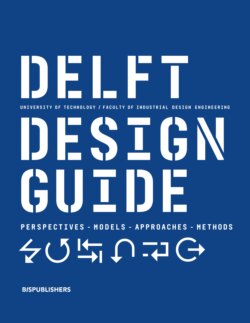Читать книгу Delft Design Guide -Revised edition - Annemiek van Boeijen - Страница 6
На сайте Литреса книга снята с продажи.
Оглавление5
introduction
Ever since its founding in the 1960s, the Delft Faculty of Industrial Design Engineering has taken a methodical approach to design education. But the methods were never uncontroversial. The Dutch writer Godfried Bomans asserted: “In the realm of the mind a method is comparable to a crutch; the true thinker walks freely.”
Many designers share his thoughts. Good designers seem to need no methods. They tend to attribute their successes to intuition, creativity and expertise, and not to the use of particular methods.
Now, nobody believes anymore that designers can do without intuition, creativity and expertise, as research into the problem-solving behaviour and thought processes of designers has convincingly shown how essential these capacities are. But that does not mean that methods have no role to play in design.
Despite criticism and doubt – some godfathers of the ‘design methods movement’ of the 1960s became critics of their own work – methods have not disappeared from the scene. Methods are often used as means of teaching design. The development of better methods is probably the most important driver of design research. And it is not uncommon for design consultancies to advertise themselves on the basis of their specific methodological approaches.
Since 1991, industrial design students at the Delft University of Technology have been raised with the book Product Design: Fundamentals and Methods that I wrote together with Johannes Eekels. The genesis of this book goes back to our lectures in the 1970s, but much of its content is still relevant. However, the field of design has changed greatly. Nowadays, industrial designers also design services and social and economic artefacts. In product development, the social and behavioural sciences have come to play a major role alongside engineering. Our awareness of the limits of production and consumption has increased enormously and unprecedented technological possibilities have emerged for the development of design tools.
Such developments have led to numerous new methods. I am extremely excited that finally a new Delft textbook that also addresses these new methods has been published. But there is more to it. Methodological textbooks usually focus on detailed descriptions of methods and barely address their application. The authors of this book have explicitly opted for the latter perspective. As good descriptions of methods are sufficiently available, they confine themselves to short characterisations of methods and refer to relevant sources for more information. How should a project plan be designed given specific objectives and available resources, when and in what situation and how should a particular method be used, and what can and cannot be expected from the use of a method? This book gives answers to these and other such questions.
Thanks to this specific focus, this book provides an important contribution to the literature on design methods. Given the success of the first edition, this book has a promising future ahead.
Norbert Roozenburg
Associate Editor of the International Journal Design Studies.
First graduate at the Delft Faculty of Industrial Design Engineering in 1971.
